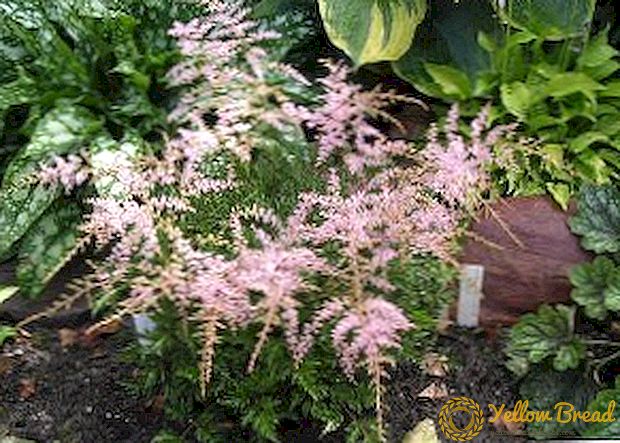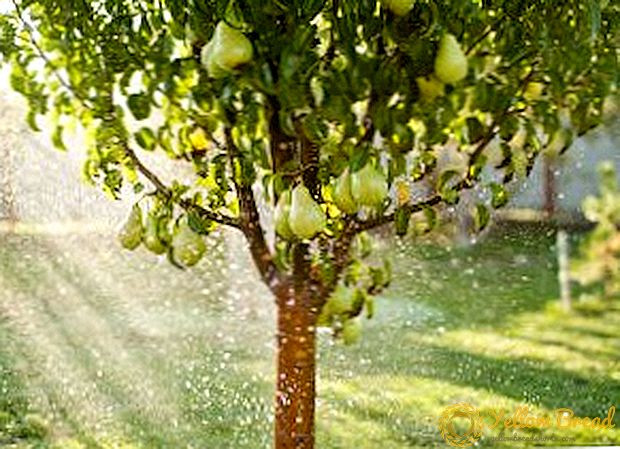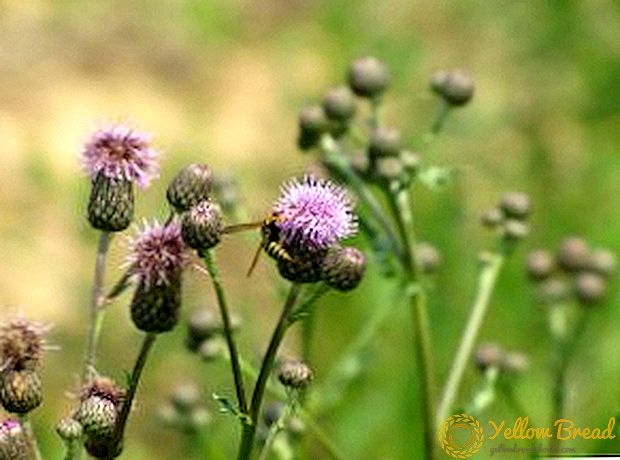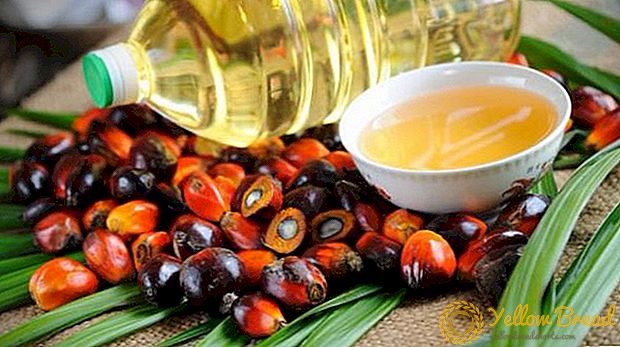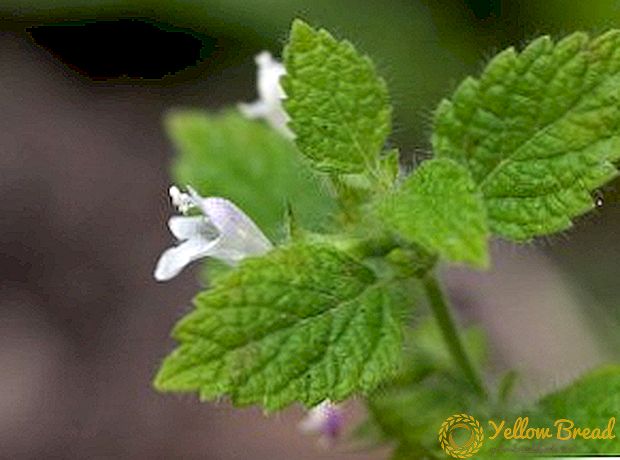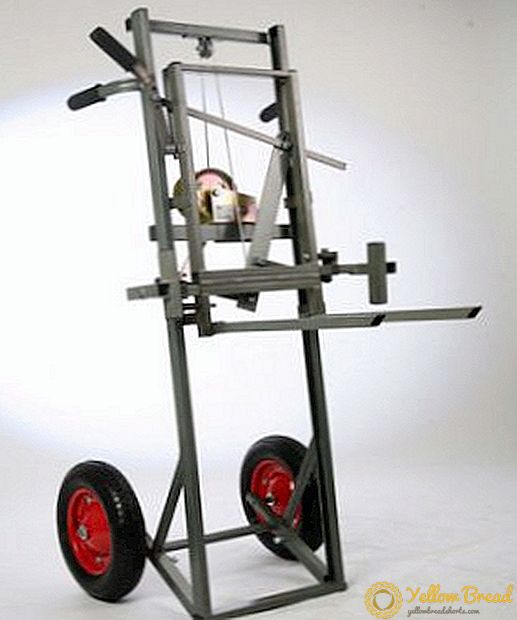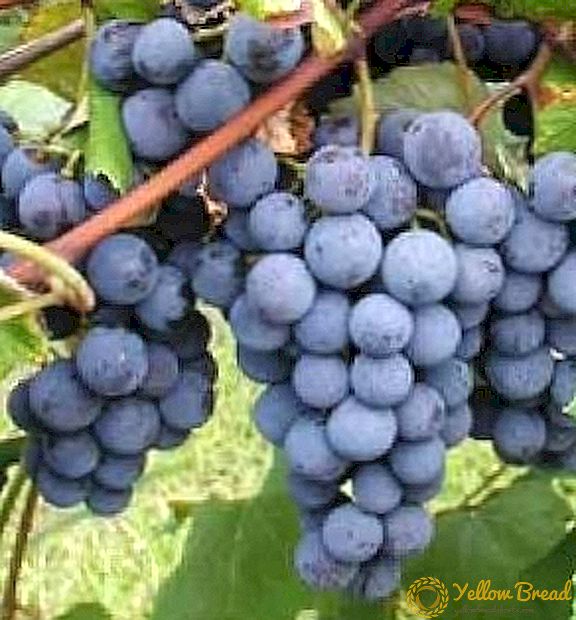
Sometimes, it seems that growing a vineyard will not be difficult, because this is a rather unpretentious culture.
But, if you want to get strong healthy bushes of grapes, you need to get acquainted with some conditions of planting and caring for them.
The grapes of "Isabella" are not only tasty, but extremely beautiful.
Sometimes they are even planted for landscaping the site, because, on a bright green background of leaves, dark blue, almost black, berries look great.
- Description of the variety
- The advantages of this grape variety
- Disadvantages variety "Isabella"
- Features planting grapes
- How to choose the best time for landing
- Vineyard Care Secrets
- Watering
- Mulching grape soil
- Proper harboring grapes
- Vine pruning
- What is vine fertilizer
- Protection of grapes from external pests
Description of the variety
In the description of the variety it should be noted that "Isabella" is a table-technical grape variety, therefore it is mainly used for making juices and wine. Juices from "Isabella" have a pleasant aftertaste and antibacterial properties, but the wine in some European countries from this grape is prohibited.According to the research done, these wines made from this grape variety contain large amounts of methanol, which is unacceptable by EU standards.
But it is worth noting that there is an increased methanol content in other alcoholic beverages, so there is reason to believe that the ban on Isabella wines is simply a way to avoid unnecessary competition for France and some other countries. In Russia, fragrant red wines from this variety are extremely popular.

Bunches of "Isabella" consist of medium in size, black, with a bluish tint, berries, covered with a dense white patina. The flesh, protected by dense, thick skin, is slightly mucous and has a pronounced strawberry flavor. The period of full maturity is up to 180 days from the moment of bud break. The cluster itself is medium-sized, and the vineyard bushes are vigorous.
Yield "Isabella" is about 70 c / ha. This indicator varies depending on climatic conditions and the presence of proper care for the vineyard. By ripening "Isabella" refers to the late varieties. You can harvest only by the end of September.
The advantages of this grape variety
The undeniable advantage of this variety is increased frost resistance, which undoubtedly simplifies the care of the vineyard, since it does not require additional protection in the form of dropping or wrapping with warming materials for the period of frost. In addition, this variety has good resistance to many fungal diseases and pests such as phylloxera.
Old vineyard bushes in the event of damage or freezing of the main branches or buds are capable of producing young shoots, which allows them to harvest a full-fledged crop all the time.
It responds well to the increased soil moisture, adapts well to different climatic zones, but one should not forget that in the northern regions this late grape may not have time to ripen before the onset of cold weather.
Disadvantages variety "Isabella"
Some disadvantages of "Isabella" include poor tolerance to drought. Due to an insufficient amount of moisture, the growth power of the vine sharply decreases and leaves fall. This variety belongs to the table-technical, so its range of use is reduced to processing into juices or wine.
Features planting grapes
Grapes are a rather unpretentious culture. It can grow on any type of soil, even in areas with poor mineral composition. But of course, before landing it is better to analyze and find out what kind of land on your site. If the soil is clay, it is necessary for the vine to make good drainage, if the site contains a large amount of peat - you need to add sand. The sandy area must be properly fertilized with manure or compost.

The only thing that grapes do not have is very good about is salt marshes. It is better to choose a well-lit area, ideal for planting will be a gentle slope, facing the south or south-west. If there is no such possibility for planting, then choose a place near the wall of the building, which will give its heat from the sun to the vine during the cold season. You can not plant bushes of grapes in places where cold air stagnates, and groundwater is located close.
14 days before landing It is advisable to dig up the vines properly, mix the acid soil with lime, in a proportion of about 200g per 1 square meter.
How to choose the best time for landing
The time for planting can be chosen both in spring and in autumn. If you decide that spring is better, then you need to wait until the earth dries out well and warms up. In the south it is about the 15th of May, and in the north, a little later, at the end of May.
Experienced winegrowers advise planting a vineyard in the autumn, because at this time it is more likely to choose good planting material, and, moreover, the vine, which was successfully planted in the autumn, will be actively growing in spring and will bear fruit before spring seedlings. After all, during the winter period its root system will get stronger and develop enough.
Autumn planting time also depends on the proximity of the onset of the first frosts in the region. So, it is already quite warm (spring) or not cold enough (autumn), the place has been chosen, the soil has been prepared, and you can proceed to planting the vine.
For one grape bush you will need recess approximately 80/80/80 cm. The bottom of the pit must be drained to 10 cm, for this purpose small pebbles, gravel or crushed stone are suitable so that there is no glut of moisture in the root system of the bush.
In the center of the recess set support from a peg or thick reinforcement.We cover the drainage layer with a layer of earth, and then with a layer of fertilizer (about 3 buckets of manure or compost, 300 g of superphosphates, 100 g of potassium salts and some wood ash). The resulting layer is thoroughly moistened, and the hole to 1/3 is complemented with a layer of earth. Around the support we make a mound of soil and set up a sapling.
Before landing shorten the main roots in the bottom of the seedling to 15cm. Sick and damaged roots are completely cut out. If the roots are poorly developed, then use an inclined landing for the germination of all nodes. Together with the roots cut and escape, leaving it up to 4 of the largest lower buds. The remaining time before planting, cut the seedling kept in the water.
After installing the bush in the landing pit it is necessary to tie up and properly straighten the roots. At the bottom we fill the ground so that the level of grafting of a seedling or the place of branching of the shoots is 3 cm above the soil level. Carefully prikapivaem bush, gradually compacting the ground. Thoroughly water the landing site.

Fertilize the soil around the seedling peat or humus. Depending on the region for planting grapes there are small features. In the southern areas, grapes are curled up to a height of 20 cm in order to avoid drying. In the north - it is desirable for a sapling to dig a trench to a depth of 50 cm, so that the roots of the grapes are sufficiently deep in the soil and are not subjected to freezing.
The distance between the rows of bushes must be observed up to 2m, and the distance between the seedlings themselves - 1.5m. The distance from the seedling to the wall is up to 50 cm, but make sure that the water flowing from the roof does not fall on the planted bushes.
It is good to plant a vineyard along the plot in one row, so it will be well lit from all sides. If all the conditions have been met, then your grapes will surely take root and will delight young shoots. After all, very little wisdom. After about 2 weeks, the first buds are already blooming. The sprouting long shoots are tied up to an established support or pegs.
Vineyard Care Secrets
Watering
Like any fruitful crop, grapes need timely and sufficient watering, especially if the weather is too dry.But, excess moisture, too, is certainly harmful. During the ripening of the cluster, with excessive watering, the berries will burst and, accordingly, lose their taste and appearance.
When watering should also take into account on which soil the vineyard is planted. If the soil is heavy clay, then it should be wetted less often, but with a sufficiently large volume of water. On sandy light soils, the moisture does not linger for a long time, so you need to water more often and with less volume.
Also, don't forget consider climatein which the vineyard is planted. After all, the frequency and abundance of irrigation depend on the temperature and humidity of the air, the depth of groundwater, grape varieties (early or late) and the time of the first frost.

After harvesting the vine is rarely watered. Very important is the last autumn watering, which is carried out with a large amount of water, in order to saturate the deep layers of moisture with the moisture and prepare the vine for successful wintering.
For a better supply of moisture to the roots, narrow grooves can be equipped so that water does not overflow around the bush. After watering, it is advisable to loosen the earth around the grapes, for better air penetration and preservation of moisture in it for a longer period. It is very useful to combine fertilizer with slurry with irrigation.Such events contribute to the stability of grapes frost.
Mulching grape soil
Soil mulching - This is a very effective agricultural practice, which is used by experienced gardeners and winegrowers. Its action is directed to many factors, for example:
- to preserve moisture in the earth around the culture;
- improving the nutrition of the grape bush;
- obstruction of the appearance of a crust on the soil surface, which reduces the access of oxygen to the root system;
- suppression and obstruction of weed growth;
- containment of soil leaching around the vine on the slopes;
- protection of the root system from freezing, during the period of severe frosts, in winter.
Mulch can be combined (consisting of several types of material) or homogeneous. Experienced winegrowers always try to keep the near-stem circle under the mulch, because the upper layer of the earth is most strongly influenced by the environment, namely, rain, wind and temperature changes.However, you should be aware that the materials themselves, from which the mulch is made, can have an effect on the soil of the near-barrel circle.
For example, mulching with straw or sawdust, which contains a sufficiently large amount of carbohydrates, enhances the consumption of nitrogen from the earth by microorganisms, actually taking it away from the culture. In this case, it is necessary either to double the amount of nitrogen fertilizers, or to precompost straw or hay in advance.

In the summer period, the mulch mixes with the ground when loosening the near-barrel circle, and in the fall it is embedded in the upper soil layer, which improves the water and nutrient regime of the culture. Mulching is suitable for all types of soils, except for excessively moist, since one of the effective advantages of this agro-technique is precisely the retention of moisture in the soil.
Highly good to use mulch on light sandy and sandy soils, as well as in places particularly arid.
Proper harboring grapes
Harboring a vineyard is required for the period of winter cold. "Isabella" is rather cold-resistant variety, which does not require additional protection, but still, young seedlings are better to warm,so as not to subject them to freezing. After all, no one can guarantee how severe the frost will be in the coming winter. Ways for warming are different: from simple wrapping with a film or a rag, to dropping along the entire length of the bush with earth.
The most successful and effective way to harbor a vineyard is needles warming, namely, spruce branches - pine or spruce branches. Through this protection air is well circulated, which does not cause the processes of decay and the development of diseases. In addition, the branches perfectly retain the snow cover, which creates an ideal environment for wintering the bush.
Film it is extremely negative to cover the vine, because during winter temperature drops, under such protection moisture accumulates, which leads to the development of mold and fungal diseases on the bush.
Do not delay with the shelter of the vineyard. If the first frosts unexpectedly appear, then there is a risk of damage to the bush when tilted to the ground. Because the cold bark becomes extremely fragile.
Vine pruning
For pruning the vine using a sharp grape pruner, which leaves a clean cut.All manipulations should begin after the foliage is reset by the shrubs and go to sleep, although many growers begin pruning in the middle of September. The main condition is that all work be completed long before the onset of the first frost.
Firstly sick and damaged shoots are removed. During these manipulations with the bush, it is required not to damage the perennial shoots, since the wounds on the grapes do not heal well. To increase the quantity and quality of the clusters, no more than 12 eyes are left on the vine per 1m2 of the area occupied by the adult bush. Remember to leave some sprouts in reserve. Since not all branches can tolerate severe frosts and may need pruning in spring.
What is vine fertilizer
Vine fertilizer in springtime consists in mulching the soil with a layer of rotted manure or compost up to 3 cm thick. Since very often the vine lacks magnesium, it is advisable to spray the bush with this solution: dissolve 250 g of magnesium sulfate in 10 liters of water.
This spraying is repeated after 14 days.During the entire growing season, feed the vineyard once a week with liquid mineral fertilizers until the berries ripen.
Protection of grapes from external pests
Protection from pests and diseases of the vineyard is extremely important. The easiest and most affordable way to handle the vine is spraying soda-salt solution (1 standard bucket of water - 10 tablespoons of salt + 5 tablespoons of food soda).
"Isabella" is fairly resistant to many pests and diseases. But, nevertheless, with a large accumulation of pests on the plot, the vineyard can also become infected. For prevention, before the start of active growth, it is possible to spray the Bordeaux fluid or solutions of iron or copper sulphate.
Also, a fairly effective way to combat pests and mold - treatment of leaves with a solution of hydrated lime. To do this, 1kg of quicklime is diluted in 3 liters of water and, only when the quenching process is over, the resulting volume of liquid is adjusted to 10 liters. The resulting whitewash, using a brush or nimbus, cover all the leaves.
We hope that our article has revealed all the features of growing the variety "Isabella", and you will be able to boast of your successful viticulture.

